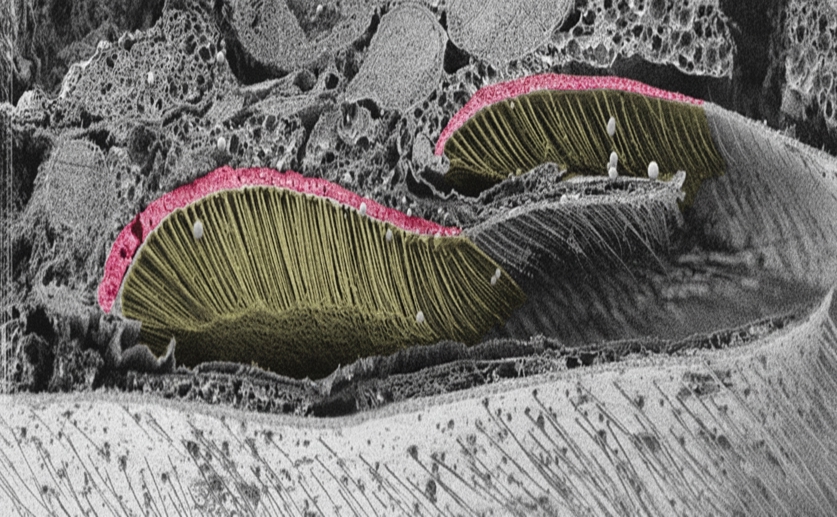Jenn Hoskins
19th October, 2025

This colorized cross-section of a male mason bee’s abdomen reveals the hidden sternal gland (red) and the bristle-filled cavity (yellow) used to store and release male-repelling pheromones.
Key Findings
- This study, conducted on mason bees in Germany, identified a specialized gland in males producing chemicals influencing mating
- Male mason bees release species-specific esters from a sternal gland that act as a deterrent, signalling their sex to other males and reducing unwanted mating attempts
- The gland’s structure—with cavities and setae—allows for both continuous pheromone release and concentrated bursts during abdominal movements, enhancing signalling range and impact
The research focused on two species of mason bee, investigating a previously uncharacterised gland located on the underside of the abdomen. This gland produces a blend of carboxylic esters – a type of chemical compound – that serve a dual purpose. Firstly, they act as a deterrent, signalling the male’s sex from a distance. Secondly, and more importantly, they function as antiaphrodisiacs, discouraging other males from attempting to mate with the same female.
This finding builds upon earlier work demonstrating that males of many species actively attempt to control female mating, often through chemical signals[2]. These signals can prevent further mating by the female, potentially increasing the male’s chances of paternity. The transfer of substances from males to females during mating has long been suspected as a key mechanism in this process[2]. However, in some species, like the mason bees studied, the exact mechanisms have remained unclear. Previous research on Osmia mason bees suggested a post-copulatory display by the male was intended to induce unreceptivity in the female, potentially through the release of an antiaphrodisiac[3]. However, this earlier work failed to detect the presence of such a substance, and observed changes in female chemical signals appeared to be age-related rather than triggered by mating[3].
The new study resolves some of these earlier uncertainties. Researchers discovered that the gland is structurally designed for both slow, continuous release of pheromones and rapid bursts. The gland itself is a simple layer of secretory cells, positioned within a dented area of the bee’s cuticle (outer shell). This dent, covered in tiny hairs (setae), creates a cavity that acts as a reservoir for the volatile pheromones. The elongated sternite (a plate-like structure on the abdomen) further enhances this storage capacity. This design allows for a constant ‘leakage’ of pheromones, providing a long-distance signal, but also enables the bee to actively release concentrated ‘puffs’ of pheromone through abdominal movements. These puffs are particularly important during mating, serving to ward off competing males.
The researchers used scanning electron microscopy to examine the gland’s structure in detail. This technique allows for high-resolution imaging of surfaces, revealing the intricate features of the gland and its surrounding cuticle. The study confirmed that the gland’s morphology facilitates the slow release of pheromones, as well as the rapid expulsion of concentrated bursts.
The discovery of this specialized gland and its function as an antiaphrodisiac provider offers a clear explanation for the observed mating behaviours in these mason bees. It supports the idea that males actively manipulate the reproductive opportunities of females to maximize their own reproductive success[2]. Unlike some other insect species where pheromone release is tied to specific behaviours or the presence of male-derived pheromones[3], the mason bee gland appears to operate with a degree of autonomy, allowing for continuous signalling and targeted bursts when needed.
EcologyPlant ScienceAnimal Science
References
Main Study
1) Morphology, ultrastructure and function of the sternal gland in two mason bee species (Osmia bicornis and O. cornuta)
Published 17th October, 2025
https://doi.org/10.1371/journal.pone.0334876
Related Studies
Related Articles

